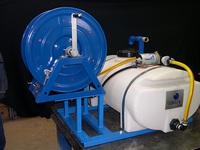Equipment Safety Checklist Part #2
Posted by Andrew Greess on Nov 16, 2014
- Is the Vehicle Load stable?
- Load stability is becoming a bigger concern as PMP’s switch to smaller vehicles and technicians have more distractions (e.g., texting). Ensure the vehicle is not overloaded and that any load is properly balanced. Pay particular attention to the power sprayer water tank, which can often be the largest portion of the load. Make sure the tank is sized appropriately to the vehicle. Consider tank baffles to reduce the water surge that can impact vehicle control and stability.
- Is it Sharp, Hot or Otherwise Dangerous?

Do a quick check of your equipment and load for hazards that could injure the technician. Here are some hazards to look for:
- Sharp
- Hot
- Moving (engine belt)
- Rough or Rusted
- Overhanging the vehicle (bump hazard)
- Are you at risk for a chemical spill?
- Check your equipment to identify potential areas for chemical leaks and spills. Heat, cold, hard use, abuse and time all take their toll on equipment. Check hoses, fittings, valves and clamps for signs of excessive wear. A cheap fitting that cracks can cause an expensive problem. Water anywhere it is not supposed to be is a problem and should be dealt with promptly.
- Chemical Buildup?
Chemical buildup can occur in the vehicle over time. This can create an exposure hazard for the technician. Keep the truck clean to protect the tech and project a great image to the public. Some places to check for chemical buildup:
- Hand sprayers and backpacks
- Water Tank
- Spray Hose
- Truck bed
A few minutes ensuring safety up front is a lot cheaper than downtime, repairs, chemical spills and lawsuits.

